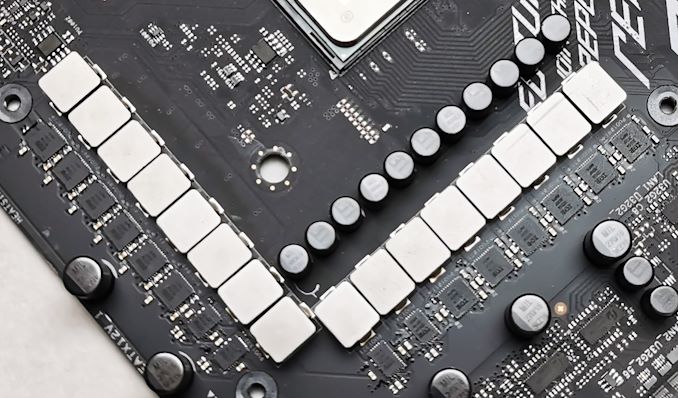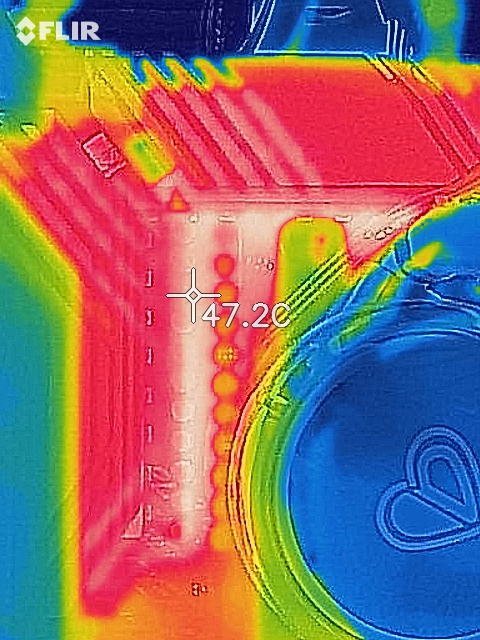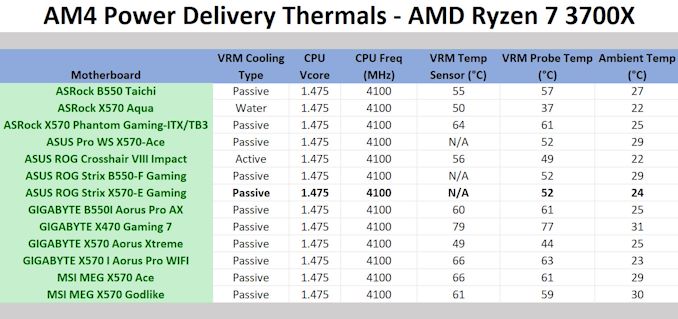The ASUS ROG Strix X570-E Gaming Motherboard Review
by Gavin Bonshor on January 25, 2021 11:00 AM EST- Posted in
- Motherboards
- AMD
- Asus
- ROG
- AM4
- Ryzen 3000
- X570
- Strix X570-E
- Ryzen 5000
- X570-E Gaming
Power Delivery Thermal Analysis
One of the most requested elements of our motherboard reviews revolves around the power delivery and its componentry. Aside from the quality of the components and its capability for overclocking to push out higher clock speeds which in turn improves performance, is the thermal capability of the cooling solutions implemented by manufacturers. While almost always fine for users running processors at default settings, the cooling capability of the VRMs isn't something that users should worry too much about, but for those looking to squeeze out extra performance from the CPU via overclocking, this puts extra pressure on the power delivery and in turn, generates extra heat. This is why more premium models often include heatsinks on its models with better cooling designs, heftier chunks of metal, and in some cases, even with water blocks.

The 16-phase (12+4) power delivery operating at 6+2 on the ASUS ROG Strix X570-E Gaming
Testing Methodology
Out method of testing out if the power delivery and its heatsink are effective at dissipating heat, is by running an intensely heavy CPU workload for a prolonged method of time. We apply an overclock which is deemed safe and at the maximum that the silicon on our AMD Ryzen 7 3700X processor allows. We then run the Prime95 with AVX2 enabled under a torture test for an hour at the maximum stable overclock we can which puts insane pressure on the processor. We collect our data via three different methods which include the following:
- Taking a thermal image from a birds-eye view after an hour with a Flir Pro thermal imaging camera
- Securing two probes on to the rear of the PCB, right underneath CPU VCore section of the power delivery for better parity in case the first probe reports a faulty reading
- Taking a reading of the VRM temperature from the sensor reading within the HWInfo monitoring application
The reason for using three different methods is that some sensors can read inaccurate temperatures, which can give very erratic results for users looking to gauge whether an overclock is too much pressure for the power delivery handle. With using a probe on the rear, it can also show the efficiency of the power stages and heatsinks as a wide margin between the probe and sensor temperature can show that the heatsink is dissipating heat and that the design is working, or that the internal sensor is massively wrong. To ensure our probe was accurate before testing, I binned 10 and selected the most accurate (within 1c of the actual temperature) for better parity in our testing.
For thermal image, we use a Flir One camera as it gives a good indication of where the heat is generated around the socket area, as some designs use different configurations and an evenly spread power delivery with good components will usually generate less heat. Manufacturers who use inefficient heatsinks and cheap out on power delivery components should run hotter than those who have invested. Of course, a $700 flagship motherboard is likely to outperform a cheaper $100 model under the same testing conditions, but it is still worth testing to see which vendors are doing things correctly.
Thermal Analysis Results

We measured 47.2°C on the hottest part of the CPU socket during our testing
The ASUS ROG Strix X570-E Gaming is using a strong looking 16-phase power delivery in a 12+4 configuration. It is using twelve International Rectifier IR3555 60 A power stages for the CPU and four IR3555 for the SoC. The board uses an ASUS specific ASP1405 PWM controller operating at 6+2, with two power stages per channel. ASUS is using teamed power stages for better transient response and lower latencies for higher bursts of power. Keeping the power delivery cool is a dual heatsink array which is interconnected by a single heatpipe.
Looking at our AM4 thermal VRM results, the X570-E Gaming performs very well and is on par with some of the best performers that have been tested so far. This is partly due to the efficient design with teamed power stages which we've seen perform well from them in the past, but the other element is the mass of the two heatsinks. Combining the two components, we measured a temperature of 52 degrees celsius from our K-Type thermocouple.
ASUS has neglected to utilize an integrated thermal sensor on all but its top tier AM4 models which is disappointing. With our thermal imaging camera, we saw a maximum temperature of 47.2 degrees Celcius which backs up our results. Compared against other AM4 models, the ASUS performs as well as its B550-F Gaming, and better than ASRock's B550 Taichi. It's a positive result for ASUS in an area they have over-engineered for better thermal performance and efficiency.











46 Comments
View All Comments
Chaitanya - Monday, January 25, 2021 - link
IO on this board is quite impressive.YB1064 - Monday, January 25, 2021 - link
Article mentions "active cooling on the chipset", yet the pictures show no fan. What gives?Green33333 - Monday, January 25, 2021 - link
The fan is hidden under the perforated shroud around where it says "speed"MilaEaston - Tuesday, January 26, 2021 - link
easy job online from home. I have received exactly $20845 last month from this home job. Join now this job and start making extra cash online. salary8 . comAninajoe - Sunday, January 31, 2021 - link
easy job online from home. I have received exactly $20845 last month from this home job. Join now this job and start making extra cash online. salary8 . comshabby - Monday, January 25, 2021 - link
Do we really need gaming benchmarks for motherboards? 😂TheinsanegamerN - Monday, January 25, 2021 - link
Yes. Some boards have inexplicably worse performance if something firmware wise is screwed up. We've seen discrepancies before. It also lets us see if a board has issues maintaining turbo boost.cbm80 - Monday, January 25, 2021 - link
It should be pass/fail. Printing numbers rewards cheating (non-defeatable overclocking of some sort).vanish1 - Monday, January 25, 2021 - link
I have this board and the PCI-E slot locks are so infuriating I've almost destroyed my board trying to remove a full size GPU from it.sibuna - Monday, January 25, 2021 - link
I have this board as well and TBH they are annoying but TBH they all are regardless of board